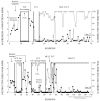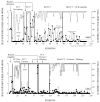Functional communication training during reinforcement schedule thinning: An analysis of 25 applications
- PMID: 26482103
- PMCID: PMC4860882
- DOI: 10.1002/jaba.265
Functional communication training during reinforcement schedule thinning: An analysis of 25 applications
Abstract
Two principal goals of functional communication training (FCT) are (a) to eliminate destructive behavior and (b) to establish a more acceptable, yet functionally equivalent, communication response (FCR). A related and critically important goal is to thin the schedule of reinforcement for the FCR to levels that can be reasonably managed by caregivers. Researchers have described several approaches to thinning FCT reinforcement schedules. We summarize the results of 25 consecutive applications (among 20 cases) in which schedule-thinning procedures employed discriminative stimuli to signal when the FCR would and would not produce reinforcement (i.e., using multiple schedules, response restriction, or chained schedules). Results suggest that schedule-thinning procedures that use discriminative stimuli can maintain the effectiveness of FCT while they minimize the need for punishment or other supplemental procedures.
Keywords: destructive behavior; functional communication training; multiple schedules; reinforcement schedule thinning.
© 2015 Society for the Experimental Analysis of Behavior.
Figures



Similar articles
-
Functional communication training with and without alternative reinforcement and punishment: an analysis of 58 applications.J Appl Behav Anal. 2013 Dec;46(4):708-22. doi: 10.1002/jaba.76. Epub 2013 Aug 22. J Appl Behav Anal. 2013. PMID: 24114463
-
Decreasing excessive functional communication responses while treating destructive behavior using response restriction.Res Dev Disabil. 2014 Nov;35(11):2614-23. doi: 10.1016/j.ridd.2014.06.024. Epub 2014 Jul 16. Res Dev Disabil. 2014. PMID: 25036315
-
A component analysis of schedule thinning during functional communication training.J Appl Behav Anal. 2013 Spring;46(1):219-41. doi: 10.1002/jaba.23. J Appl Behav Anal. 2013. PMID: 24114096
-
Using Chained or Tandem Schedules With Functional Communication Training: A Systematic Review.Behav Modif. 2023 Jan;47(1):185-218. doi: 10.1177/01454455221077420. Epub 2022 Feb 14. Behav Modif. 2023. PMID: 35164521
-
Thinning Schedules of Reinforcement Following Functional Communication Training for Children with Intellectual and Developmental Disabilities: A Meta-analytic Review.J Autism Dev Disord. 2019 Dec;49(12):4788-4806. doi: 10.1007/s10803-019-04191-x. J Autism Dev Disord. 2019. PMID: 31456100 Review.
Cited by
-
Sustaining behavior reduction by transitioning the topography of the functional communication response.J Appl Behav Anal. 2021 Jun;54(3):1013-1031. doi: 10.1002/jaba.824. Epub 2021 Mar 13. J Appl Behav Anal. 2021. PMID: 33713450 Free PMC article.
-
Updated Recommendations for Reinforcement Schedule Thinning following Functional Communication Training.Behav Anal Pract. 2023 Oct 11;17(1):87-106. doi: 10.1007/s40617-023-00863-4. eCollection 2024 Mar. Behav Anal Pract. 2023. PMID: 38405284 Free PMC article. Review.
-
Relapse during the treatment of pediatric feeding disorders.J Appl Behav Anal. 2022 Jun;55(3):704-726. doi: 10.1002/jaba.913. Epub 2022 Mar 22. J Appl Behav Anal. 2022. PMID: 35318658 Free PMC article.
-
Treating destructive behavior reinforced by increased caregiver compliance with the participant's mands.J Appl Behav Anal. 2020 Jul;53(3):1494-1513. doi: 10.1002/jaba.674. Epub 2020 Jan 19. J Appl Behav Anal. 2020. PMID: 31957868 Free PMC article.
-
An Evaluation of Ethnicity-Matching for Caregiver Telehealth Training in India.Behav Anal Pract. 2022 Sep 8;16(2):573-586. doi: 10.1007/s40617-022-00738-0. eCollection 2023 Jun. Behav Anal Pract. 2022. PMID: 37187850 Free PMC article.
References
-
- Betz AM, Fisher WW, Roane HS, Mintz JC, Owen TM. A component analysis of schedule thinning during functional communication training. Journal of Applied Behavior Analysis. 2013;46:219–241. doi: 10.1002/jaba.23. - PubMed
-
- Fisher WW, Greer BD, Querim AC, DeRosa N. Decreasing excessive functional communication responses while treating destructive behavior using response restriction. Research in Developmental Disabilities. 2014;35:2614–2623. doi: 10.1016/j.ridd.2014.06.024. - PubMed
Publication types
MeSH terms
Grants and funding
LinkOut - more resources
Full Text Sources
Other Literature Sources
Medical

